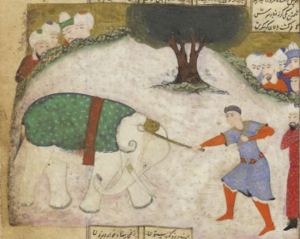About this manuscript
Or. 494 was produced in Shiraz, the capital of the province of Fars, which was at the time a part of the Timurid Empire. It was one of twelve key manuscripts (dated between 614/1217 and 894/1489 and seen as relatively close to the original) Djalal Khaleghi-Motlagh collated in one of the most recent quests for Firdawsī’s own text. In Khalegi-Matlogh's edition added materials, no matter how popular, have no place. In this manuscript too, he found some passages which he considered spurious and discarded. One of these is about the hero Rustam, one of the major legendary characters in the Shāhnāma.
Rustam belongs to the ruling family of Sistan, who were vassals to the kings of Iran. He is a true champion who performs heroic deeds in the service of the kings of Iran, with proverbial strength. He excels in battles with Iran’s archenemy Tūrān (see for example fol. 180r), but also in fighting supernatural forces, for example in the famous episode entitled Haft Khwān, or ‘Seven Trials’.

In Or. 494, Rustam’s importance is emphasised by the fact that six of the eighteen illustrations depict him (49r, 67r, 89v, 180r, 204r, 318r). Some of these, featuring Rustam and Suhrab (f 89v) for instance or Rustam and the White Demon (f 67r), occur in most illustrated Shāhnāma manuscripts. Others, with Iskandar en Gushbistar ( ) for instance, are less common.
The passage Khaleghi-Motlagh omitted begins here on f 48v, in the line immediately above the rubric, and it ends with the penultimate verse on fol. 50v. (Khaleghi Motlagh picks up again with the last verse on the page, starting with Manūchihr chun sāl shud bar du shast.) It is part of a story entitled Dāstān-i Rustam bā pīl-i sapīd, ‘The Story of Rustam and the white elephant’, in which Rustam, still a child, manages to defeat a rampant white elephant. The title is written in blue in a rubric on f 48v and the episode is illustrated on f 49r.
The story fits well in the general storyline of Firdawsī and features in the majority of Shāhnāma manuscripts, including seven of Khaleghi-Motlagh's "key manuscripts". Khalegi-Motlagh doubts that Firdawsī himself wrote about Rustam and the white elephant and relegates the story to the footnotes as a rivāyat-i ilhāqī – an added story.
If, however, Or. 494 as well as other early Shāhnāma manuscripts include this apparently “false” passage, it is not difficult to imagine how many doubtful verses, passages and entire epics form part of the Shāhnāma manuscript tradition as a whole. It is obviously a hazardous enterprise to try to establish a kind of definitive text. Moreover, it is an enterprise that goes against the quality of the Shāhnāma as a living epic: it was precisely because of its fluidity and adaptability that the Shāhnāma not only survived, but also gained in importance during the thousand years of its existence.
More about this manuscript: Lesson 24
Further reading
Gabrielle van den Berg, 'Demons in the Persian Epic Cycle: The Div Shabrang in the Leiden Shabrangnama
and in Shahnama Manuscripts' in Shahnama Studies II. The Reception of the Shahnama. C. Melville and G. van den Berg and C. Melville (eds). Brill, 2012, 35-47. https://doi-org.ezproxy.leidenuniv.nl:2443/10.1163/9789004228634_004
Marjolijn van Zutphen, ' Banu Gushasp in the Shahnama: A Case Study of the British Library Ms. Or. 2926 and the Interpolated Banu Gushaspnama' in Shahnama Studies III. The Reception of the Shahnama. G. van den Berg and C. Melville (eds), Brill, 2018, 9-32. https://doi-org.ezproxy.leidenuniv.nl:2443/10.1163/9789004302457_003
Firuza Abdullaeva and Charles Melville, The Persian Book of Kings: Ibrahim Sultan’s Shahnama. Oxford: The Bodleian Library, University of Oxford, 2008.
Questions
-
Throughout the history of the Shāhnāma extra passages have been interpolated in the text. Such passages occur in thousands of manuscripts that have not yet been studied and can be a wonderful source for historical research in themselves. But how can such undiscovered material be recognized, that is localised, in a specific manuscript?
-
On folio 268r and 269r you find sections of diagonal script or chalīpā. Why, do you think, did the scribe apply this?
